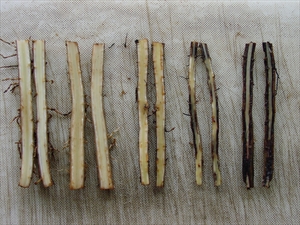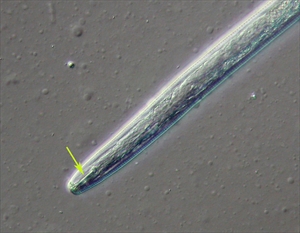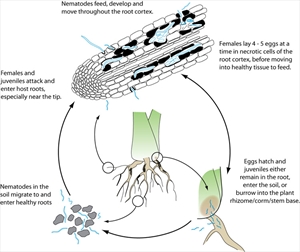Banana burrowing nematode, black head disease of banana
Pacific Pests, Pathogens, Weeds & Pesticides - Online edition
Pacific Pests, Pathogens, Weeds & Pesticides
Banana burrowing nematode (257)
Radopholus similis
Radopholus simils is recorded from Asia, Africa, North (Hawaii, Florida), South and Central America, the Caribbean, Europe, Oceania. The nematode is recorded from American Samoa, Australia, Cook Islands, Fiji, French Polynesia, Guam, Federated States of Micronesia, New Caledonia, Niue, Palau, Papua New Guinea, Samoa, Solomon Islands, and Tonga. Note, in Fiji, the nematode is highly pathogenic on ginger (see Fact Sheet no. 161), but less so on banana; in other countries bananas are readily infected
Wide. Several hundred plant species are hosts of the nematode. It is a major disease of banana and plantain, black pepper, giant swamp taro (see Fact Sheet no. 203), ginger (see Fact Sheet no. 161), tea, but also important on palms (Arecaceae), maize and sugarcane (Poaceae), cabbages (Brassicaceae), and tomatoes (Solanaceae). Note that Radopholus on citrus in Florida was first thought to be a different strain when first reported in the 1920s, but later was given a different name, Radopholus citrophilus.
The burrowing nematode destroys the roots of bananas and plantains so that the plants are starved of water, nutrients, and lack support. Consequently, (i) the mother plants and suckers grow slowly, the number and size of leaves is smaller than normal, leaves are yellowish, and fruit bunches are small, or (ii) the plants fall down in heavy rain or winds before fruits are mature, a symptom known as 'toppling' (Photo 1).
The fine feeder roots are killed, whereas the larger anchoring roots develop dark red streaks as far as the central parts, known as the stele. The lesions join together, and turn black as they are invaded by other microorganisms. Rots occur. Finally, the rots form a ring around the root and kill it (see Photo 2 for stages of infection). The corms are also infected, and black areas form, known as 'black heads'. As roots die, new ones grow from the corms and they, too, become infected by nematodes and are killed.
The symptoms are similar to those caused by the lesion nematode, Pratylenchus coffeae (see Fact Sheet no. 08). Based on symptoms alone, it is not possible to tell which of these two nematodes is the cause.
The life cycle (Diagram) is completed in 20-25 days depending on the temperature, within the roots of banana. Eggs are laid in the roots, in the tissues outside the central water-conducting parts, and the young nematodes (called juveniles) and females migrate through the roots or emerge in search of new ones. There are four young stages before they become wormlike adults, less then 1 mm long, with long tapering tails. The head of the male is knob-like and the stylet or spear in the mouth (Photo 3) is not as well developed as that of the female, and the male does not feed. It is also smaller than the female.
Spread is in soil water, or infested soil on shoes, tools, or machinery. Long distance spread is in the roots, lower stems, corms, and rhizomes used for propagation.
The borrowing nematode causes losses of between 30 and 60% in the yield of bananas and plantains. The difference depends on soil fertility, with greatest losses in 'poor' soils, those lacking organic materials. There are also differences between populations around the world in the symptoms they cause, and the variety of banana preferred by the burrowing nematodes.
Look for mother and sucker plants that are growing slowly, with yellowish unhealthy leaves. Inspect the roots, break them open lengthways and look for the dark red streaks in the outer parts, enlarging and turning black. Look for plants that have fallen over in heavy rains and strong winds before the fruits have ripened.
QUARANTINE
Exclusion of the nematode by plant quarantines is of little practical value. The burrowing nematode has been found in nearly all banana producing regions of the world, having been distributed on planting sets of Cavendish varieties, in particular.
The main aim of management is to reduce the population of the nematode in the soil and to use plants free from infection.
CULTURAL CONTROL
Pre-plant treatments of banana plants and/or soil are important in order to reduce or delay the effects of the burrowing nematode on the crop.
Before planting:
- Fallow the land for 10-12 months if infested with burrowing nematode, and banana crops no longer give acceptable returns. Remove or plough-in weeds. The nematodes live for about 6 months in soil free from host plants and weeds.
- Plant cover crops that produce chemicals in the soil that reduce nematode populations, e.g. Crotalaria (sunnhemp) or Tagetes (marigold), or plant the grass Panicum maxicum.
- Add organic materials to the soil to improve fertility, increase root development and stimulate natural biological control.
- Improve soil drainage in high rainfall areas.
- Use plants from tissue culture if these are available and affordable, especially if planting into land where bananas have not been grown previously.
After harvest:
- Use passion fruit (Passiflora edulis) or pineapple (Ananas comosus) in rotations between crops of banana.
RESISTANT VARIETIES
Two widely confirmed sources of resistance to burrowing nematode are Pisang Jari Buaya (AA) and Yangambi Km 5 (AAA). Pisang Jari Buaya has been used in the breeding program that produced FHIA.01, known as Goldfinger.
HOT WATER TREATMEN
- Treat planting material of banana or plantain first by peeling the suckers, cutting out all obvious signs of corm infection, and then with hot water at 50°C for 20-25 minutes, with careful monitoring of temperature. (Note hot water treatment for the control of burrowing nematode in ginger is 52°C for 10 minutes).
- IITA, the International Institute of Tropical Agriculture, advises dipping peeled suckers of banana and plantain in boiling water for between 20 and 30 seconds. This method has the advantage that a thermometer is not required, only a watch with a second hand. (If no watch, take 30 pebbles, place them on the floor and pick them up one at a time and put into a small container). Note, this test applies to banana and plantain only.
CHEMICAL CONTROL
Most nematicides are difficult to apply, especially if they are fumigants or have to be injected into the soil. Many are toxic to humans, need regular application, and all are expensive. For these reasons, and the fact that they have a negative impact on the environment, as they destroy all soil organisms, they are not recommended for smallholders.
AUTHOR Grahame Jackson
Information (and Diagram) from Brooks FE (2014) Burrowing nematode. The Plant Health Instructor. (https://www.apsnet.org/edcenter/disandpath/nematode/pdlessons/Pages/Burrowingnematode.aspx); and Hauser S, Coyne D (2010) A hot bath cleans all: Boiling water treatment of banana and plantain. (https://www.ctc-n.org/sites/www.ctc-n.org/files/resources/4ea6bfcd-2658-4dac-bf31-03861661b3dc.pdf); and Vézina A, et al. (2020) Radopholus similis. ProMusa. (https://www.promusa.org/Radopholus+similis); and from Sikora NS, Crow W (2018) Featured Creatures, Entomology & Nematology. UF/IFAS, University of Florida. (http://entnemdept.ufl.edu/creatures/NEMATODE/Radopholus_similis.htm). Photos 1-3 Fred Brooks, Plant and Environmental Protection Services, University of Hawaii at Manoa, Honolulu.
Produced with support from the Australian Centre for International Agricultural Research under project PC/2010/090: Strengthening integrated crop management research in the Pacific Islands in support of sustainable intensification of high-value crop production, implemented by the University of Queensland and the Secretariat of the Pacific Community.







